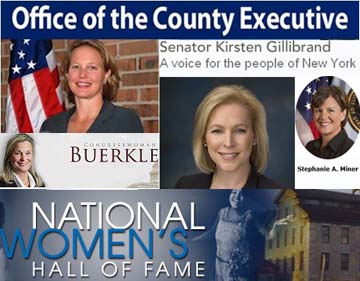In a region rich with feminist history, four recently elected women are following in some big political footsteps.
In Central New York, U.S. Rep. Ann Marie Buerkle, R-Onondaga Hill, and Sen. Kirsten Gillibrand, D-N.Y., represent voters in Congress. And Syracuse’s mayor, Stephanie Miner, and Joanie Mahoney, the Onondaga County executive, help shape local laws.
That’s a high concentration of female power, compared with a nation overwhelmingly and disproportionately governed by men.
“I don’t know how you can explain it, except maybe at this moment in time there are more female candidates,” Mahoney told Democracywise in December.
The four female politicians in Central New York remain in the minority of elected officials. Although women make up just more than half of the U.S. population, governments at all levels are still predominantly male. Consider the following statistics from the Center for American Women in Politics at Rutgers University:
- 83 percent of all members of Congress are men.
- Only 23 percent of state legislators nationwide are women. In New York’s state legislature, women make up 22.6 percent of representatives.
- Of cities with populations greater than 30,000, only about 17 percent have female mayors.
This general underrepresentation of women in politics can be attributed to the structure of the American electoral process and to sociological factors that make men more likely to see themselves as viable candidates, experts say.
“There’s a whole social structure that’s pushing men to get into this more than women,” said Syracuse University political scientist Kristi Andersen, who is also one of the local women elected to public office. She is on the town board of Cazenovia.
Historians say the election of four women in Central New York reflects the region’s deep feminist roots. In the 19th Century, New York suffragists led the fight for political equality from their homebase in the Finger Lakes region. Seneca Falls was the site of the Women’s Rights Convention in 1848. It was organized by Lucretia Mott, Elizabeth Cady Stanton, Mary Ann M’Clintock, Jane Hunt and Martha Coffin Wright. The convention is often cited as the birthplace of America’s women’s suffrage movement.
“The work that was being done in Seneca Falls in 1848 is still being done by female—and male—politicians today,” says Christine Moulton. She is executive director of the National Women’s Hall of Fame in Seneca Falls, about 40 miles east of Syracuse.
Throughout history, according to the Center for American Women in Politics, New York was also home to these firsts for women:
- In 1866, Elizabeth Cady Stanton became the first woman to run for the U.S. House of Representatives, running as an independent.
- In 1968, Shirley Chisolm, D-Brooklyn, became the first black woman ever elected to Congress. She served in the House until 1982.
- In 1984, U.S. Rep. Geraldine Ferraro, D-Queens, became the first woman to run for vice president on a major party ticket when Walter Mondale selected her as his running mate.
- In 1992, U.S. Rep. Nydia Velasquez, D-Brooklyn, became the first Puerto Rican woman elected to Congress, where she serves to this day.
- In 2001, Hillary Clinton became the first woman to serve as a U.S. senator representing New York. She was also the first First Lady elected to public office. In 2008, then-Sen. Clinton became the first female presidential candidate to be on the ballot in primaries and caucuses in every state. She is now the Secretary of State.
Today, women have made strides toward political equality, especially since the feminist movement of the 1960s, political scientists say.
SU political scientist Andersen says her research shows that women are “often perceived as more compassionate, less corrupt, more honest and more in touch with their constituents” than the men they run against.
Despite that potential advantage for female candidates, Andersen said, women face a tougher battle to get elected in America than in other countries because of differences in electoral processes.
In many European democracies, political parties have required gender quotas, so a woman automatically gets voted into national office if she’s risen to power within her party. “She doesn’t have to raise money herself or campaign against an opponent,” she said.
But in the U.S., women must get a majority of the public’s votes to take office. This helps explain, Andersen said, why the U.S. ranks 90th in the world for women’s representation in its national legislature.
When they campaign for any level of office, female politicians face the sometimes tough decision of whether to make gender an issue in their campaigns, Andersen said.
Women’s recognition of this choice can be seen in their televised campaign ads, she said. Female politicians are less likely than men to show their families in ads for fear of being perceived as weak. On the other hand, Andersen said, female politicians like Hillary Clinton are often criticized as “too masculine.”
Said Andersen: “They have to make the choice to run as a woman and stress women’s issues or downplay it.”
(Jessica Palombo is a graduate student in broadcast and digital journalism.)
-30-



